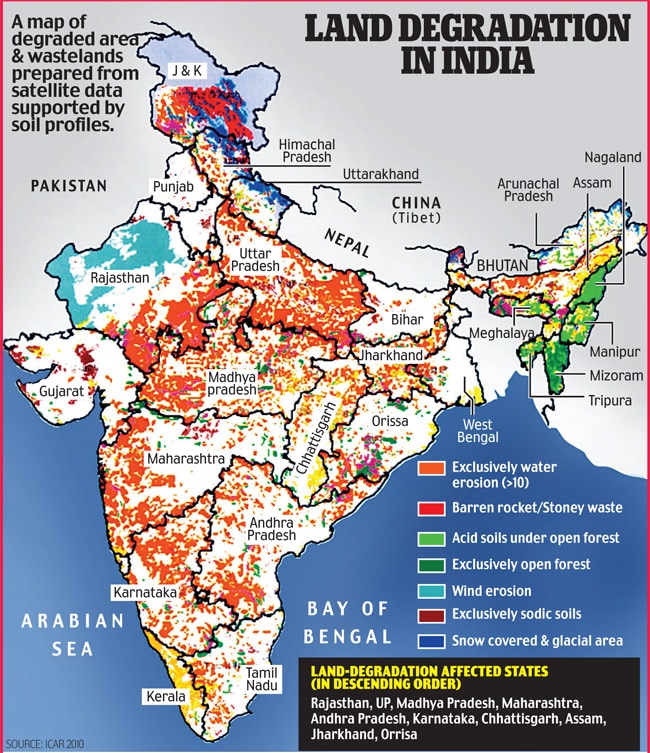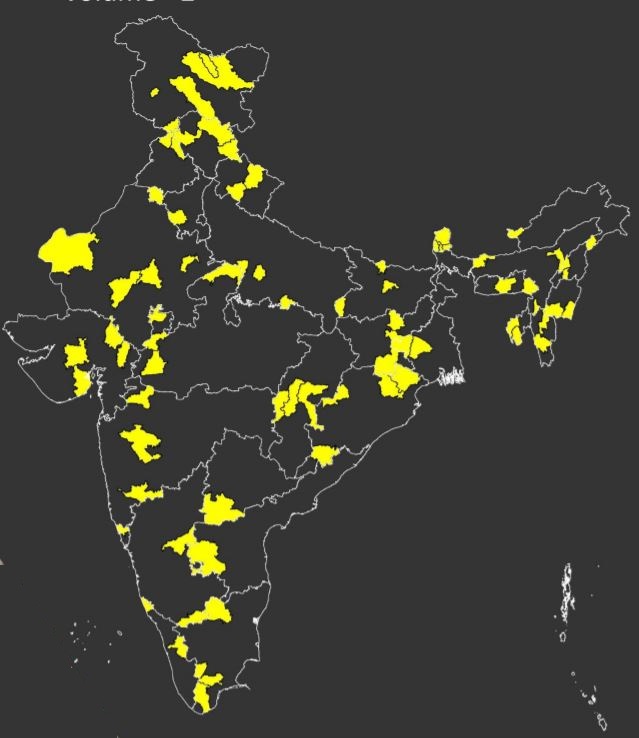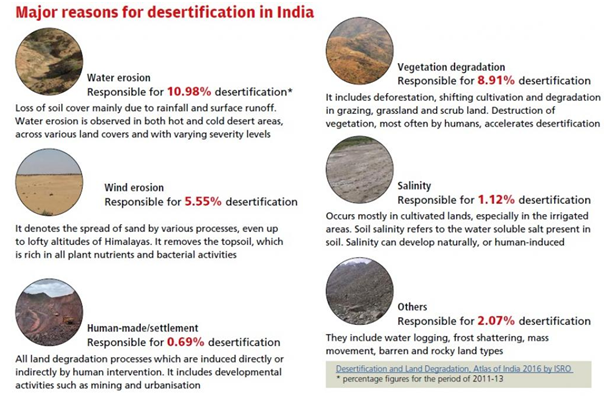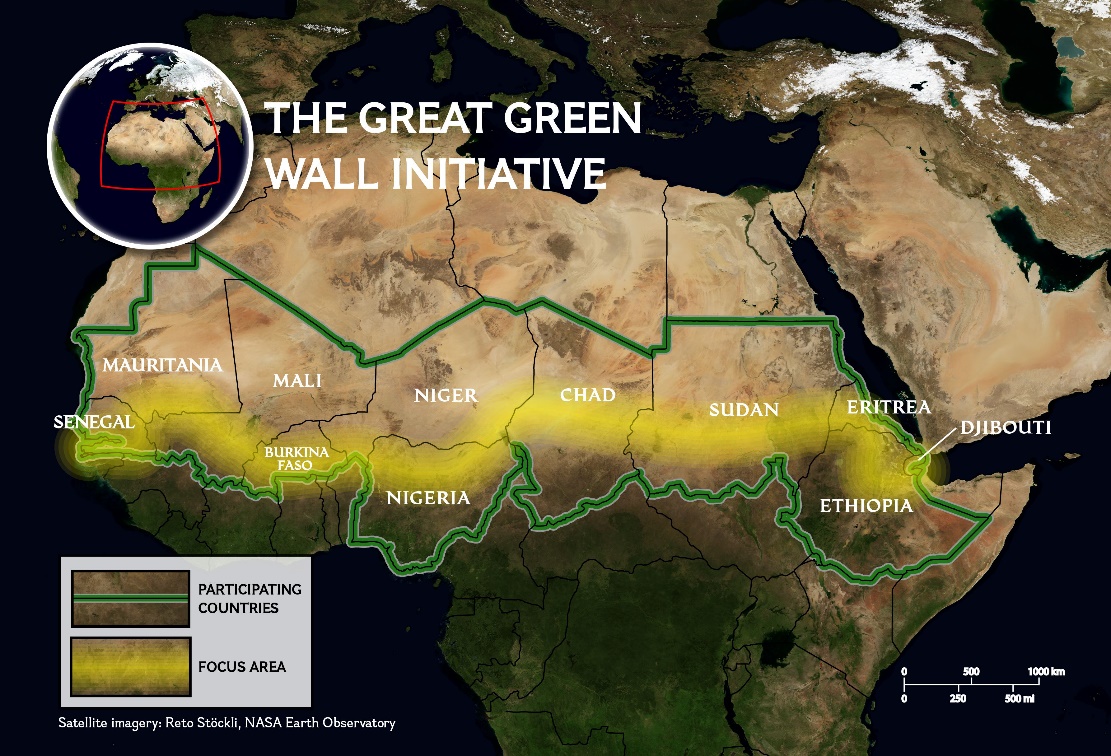Desertification in India
2021 JUN 21
Mains >
Environment & Ecology > Degradation & Deforestation > Land reforms

IN NEWS:
- Prime Minister Narendra Modi, in his keynote address at a United Nations high-level dialogue on Desertification, Land Degradation and Drought, said India is on track to achieve its national commitment on land degradation neutrality, and that it’s working to restore 26 million hectares of degraded land by 2030.
WHAT IS DESERTIFICATION?
- UNCCD defines desertification as “land degradation in arid, semi-arid and dry sub-humid areas resulting from various factors, including climatic variations and human activities”.
DESERTIFICATION IN INDIA
According to ‘Desertification and Land Degradation of Selected Districts of India’, an atlas published in 2021 by the ISRO’s Space Application Centre (SAC), Ahmedabad:
- 96.40 million ha, or about 29.32% of the Total Geographic Area (TGA) of the country is undergoing degradation.

- State-wise analysis:
- Around 23.95% of desertification/land degradation is contributed nine states: Rajasthan, Maharashtra, Gujarat, Jammu & Kashmir, Karnataka, Jharkhand, Odisha, Madhya Pradesh and Telangana.
- Jharkhand, Rajasthan, Delhi, Gujarat and Goa have more than 50% area under desertification/land degradation.
- Kerala, Assam, Mizoram, Haryana, Bihar, Uttar Pradesh, Punjab and Arunachal Pradesh had less than 10% area under desertification/land degradation.
CAUSES OF DESERTIFICATION IN INDIA:
- Erosion by elements:
- The most significant process of desertification/ land degradation in the country is due to water Erosion, followed by wind erosion.

- Green revolution:
- Practices that were the core of green revolution, such as chemical fertilizers, mechanized tillage, excessive irrigation and intense monoculture has altered the structure of the soil, leading to its salinization and subsequent degradation.
- Unsustainable land use practices:
- Unplanned and unscientific activities, which outweigh the carrying capacity of the soil, can lead to soil erosion.
- Eg: The monoculture of water intensive crops in the semi-arid Punjab plains has resulted in groundwater depletion and desertification. In Nagaland, shifting cultivation and deforestation to meet the needs of the rising population are to blame for desertification.
- Removal of natural vegetation:
- Clearing of forests and green cover for urbanisation and developmental activities aggravates the effect of natural elements of erosion on soil. In fact, vegetation Degradation is the second most significant cause of land degradation in India after water erosion.
- Eg: The degradation in Aravalli hills, due to clearing of natural vegetation for real estate.
- Loss of soil moisture
- Soil can lose its moisture due to several reasons, like deficit in annual rainfalls, prolonged droughts or depletion of groundwater. Continued loss of moisture can eventually lead to degradation and desertification.
- Eg: In Andhra Pradesh, low rainfall and increased dependence on borewells have led to soil aridity, while less snow and more rainfall has deepened the desertification crisis in Himachal Pradesh.
- Mining:
- Large scale mining, especially open pit mining, results in the removal of top soil and vegetation, leading to soil erosion and degradation. This is evident along the mineral belts of Jharkhand.
- Overgrazing:
- Uncontrolled grazing of pastures is the largest cause of desertification in the world. In India, overgrazing and encroachment of grassland for agricultural activities are the causes for land degradation in Gujarat.
- Pollution:
- Acid rains, overuse of fertilizers, dumping of wastes in landfills, leaching of heavy metals etc can lead to soil degradation.
IMPACTS OF DESERTIFICATION:
- Economic loss:
- The Energy and Resources Institute’s (TERI) conservative estimate shows land degradation costs USD 48.8 billion to the country’s exchequer annually.
- Threaten food security:
- Land degradation threatens agricultural productivity and can lead to food insecurity. This will have repercussive impacts on poverty alleviation as well as affects the overall productivity of the economy.
- Impacts Microclimate:
- Degradation can lead to destruction of vegetation, which will affect the region’s climate and also contributes to climate change.
- Reduce Carbon storage:
- Loss of green cover, soil infertility and increased soil erosion reduces the soil’s potential to store carbon. This in turn contributes to global warming and aggravates climate change.
- Affects water retention:
- Land degradation can reduce the infiltration of water, which results in lower groundwater table and
- Aggravates disasters:
- Excessive soil erosion due to land degradation can destabilise slopes leading to landslides. Siltation of rivers due to erosion reduces the carrying capacity of rivers, thereby leading to severe floods and intense droughts.
- Socio-Political Impacts:
- Land degradation has serious knock-on effects for humans, such as malnutrition, disease, forced migration, cultural damage, and even war.
- Eg: Protracted drought and loss of fertile land may have been contributing factors in the wars in Sudan and Syria.
- Eg: Recent farmer agitations and resultant resignation of elected members of allies from ruling coalitions
INTERNATIONAL EFFORTS TO PREVENT DESERTIFICATION:
- United Nations Convention to Combat Desertification (UNCCD):
- It is the sole legally binding international agreement linking environment and development to sustainable land management.
- The Bonn Challenge:
- To bring 150 million hectares of the world’s deforested and degraded land into restoration by 2020, and 350 million hectares by 2030.
- Goal 15 of Sustainable Development Goals (SDG), 2030:
- It declares that “we are determined to protect the planet from degradation, including through sustainable consumption and production.”
- Land Degradation Neutrality fund:
- The LDN Fund is a first-of-its-kind investment vehicle leveraging public money to raise private capital for sustainable land management and landscape restoration activities worldwide that contribute to the achievement of land degradation neutrality.
- The World Day to Combat Desertification and Drought is observed every year on 17th June.
|
Africa’s Great Green Wall:
- Launched in 2007 by the African Union, this initiative aims to restore Africa’s degraded landscapes and transform the Sahel region.
- The ambition of the initiative is to restore 100 million ha of currently degraded land; sequester 250 million tons of carbon and create 10 million green jobs by 2030.
- Investment for the project is provided by the Global Environment Facility (GEF), in close partnership with the World Bank.

|
INDIA’S EFFORTS TO CURB DESERTIFICATION:
- Commitment to UNCCD and SDGs:
- India is a signatory to the United Nations Convention on Combating Desertification (UNCCD). The country is committed to combat desertification and land degradation and intends to achieve land degradation neutral status by 2030. MoEF&CC is the nodal Ministry for the implementation of the UNCCD.
- India has adopted the goal of achieving Land degradation Neutrality by 2030 as adopted under Sustainable Development Goals.
- National Action Programme to Combat Desertification:
- The National Action Plan (NAP) to combat desertification was launched in 2001 for 20 years to address issues of increasing desertification and to take appropriate actions.
- Delhi Declaration:
- India hosted the COP 14 to UNCCD and adopted new targets:
- India raised its total area that would be restored from its land degradation status, from 21 million hectares to 26 million hectares till 2030.
- Set up a Centre of Excellence at the Forest Research Institute, Dehradun, for providing technical assistance to meet the challenges.
- Pradhan Mantri Krishi Sinchai Yojana:
- Launched with the motto of "Har Khet Ko Paani", PMKSY is being implemented to expand cultivated area with assured irrigation, reduce wastage of water and improve water use efficiency.
- One of the components of the scheme, Integrated Watershed Management Programme, aims to restore ecological balance by harnessing, conserving and developing degraded natural resources with the creation of Rural Employment.
- Desert Development Programme:
- To minimize the adverse effect of drought and to rejuvenate the natural resource base of the identified desert areas.
- It was launched for hot desert areas of Rajasthan, Gujarat, Haryana and cold desert areas of Jammu & Kashmir and Himachal Pradesh.
- National Afforestation Programme:
- The objective of the NAP is the ecological restoration of degraded forests and to develop the forest resources with peoples’ participation, with focus on improvement in livelihoods of the forest-fringe communities.
- Soil health card scheme:
- Soil health card is field-specific detailed report of soil fertility status and other important soil parameters that affect crop productivity.
- SHC is provided to all farmers at an interval of 3 years to enable the farmers to apply recommended doses of nutrients and hence realize improved and sustainable soil health and fertility, low costs and higher profits.
- National Mission on Green India:
- It is a part of the National Action Plan on Climate Change (NAPCC). It has the objective of protecting, restoring and enhancing India’s diminishing forest cover with a deadline of 10 years.
- Mapping of area:
- Desertification and Land Degradation Atlas of India is released by ISRO. Combating desertification and land degradation is one of the thrust areas covered by it.
- Other efforts:
- Command Area Development and Management Programme: Launched to improve the irrigation potential utilization and to optimize agricultural production through efficient water management.
- Soil Conservation in the Catchment of River Valley Projects and Flood Prone Rivers: The scheme aims at improving the physical conditions and productivity status of alkali soils for restoring optimum crop production.
- Fodder and Feed Development Scheme: It aims to improve degraded grassland and also the vegetation cover of problematic soils like saline, acidic and heavy soil.
WAY FORWARD:
- Watershed development: Integrated watershed management, which involves soil and water conservation coupled with suitable crop management, is another excellent strategy for mitigating soil erosion and land degradation.
- Promote sustainable agriculture: India needs to encourage crop rotation, crop diversification, micro-irrigation, organic farming etc. if it is to tackle desertification.
- “Green Walls” And “Green Dams”: Natural windbreaks should be constructed to reduce the rate of desertification, through afforestation, and ecosystem restoration programmes
- Integrated Nutrient Management and Organic Manuring: Integrated nutrient management, i.e., the application of NPK mineral fertilizers along with organic manure, increases crop productivity, and decreases soil loss.
- Recognizing the key role of Land managers, including indigenous people and local communities in the design, implementation and evaluation of sustainable land management practices.
- Sustainable Urban planning: Focus on urban greenery, replanting with native species, green infrastructure development, remediation of contaminated soils, wastewater treatment and river channel restoration.
- Eliminate incentives that promote degradation like subsidies that reward overproduction, and devising positive incentives to reward the adoption of sustainable land management practices.
- Reclamation of affected Soils and Drainage, through measures such as using lime and gypsum, zero tillage, use of leguminous crops and organic fertilizers. Mined land can be better reclaimed by proper back filling of topsoil and revegetating them with the help of geo-textiles.
- Pollution Control: Domestic and municipal wastes, sludges, pesticides, industrial wastes, etc. need to be used with utmost caution to avoid the possibility of pollution of soil.
PRACTICE QUESTION:
Q. Examine the causes of desertification in India. What measures have been taken by the Government to prevent land desertification?


